We are aiming to build up a collection of pictures of plants, particularly wild flowers photographed growing in Ryedale. The photos are roughly in order of flowering through the year. Plants flowering January–April and July–December are in different files, as are more from May–June. (This page could take a while for all the pictures to load...)
 | Cranesbill, meadow, Geranium pratense
Meadow cranesbill is common along roadside verges, with its blue flowers often producing a striking show, especially if the verge has been cut after the cow parsley finishes flowering. 15.6.99 |
 | Barberry, Berberis vulgaris
This spiny bush is the ancestor of garden barberries, with yellow flowers in spring followed in late autumn by egg-shaped red berries which can be made into (tart) jelly. 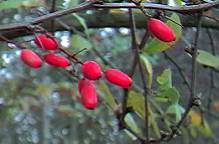 It used to be much commoner, but as the plant acts as an intermediate host for a fungal rust disease of barley most of it was eradicated. There are still one or two plants to be found in Ryedale, growing in old-established hedges. The picture shows the characteristic 3-way spines on a new shoot, and the inset is of the flowers. 15.6.99 It used to be much commoner, but as the plant acts as an intermediate host for a fungal rust disease of barley most of it was eradicated. There are still one or two plants to be found in Ryedale, growing in old-established hedges. The picture shows the characteristic 3-way spines on a new shoot, and the inset is of the flowers. 15.6.99
The picture of the berries (right) was taken (from the same bush) 15.11.2000; 2000 was a particularly good year for the berries.
Details (below) show the finely toothed leaves and the detailed structure of the flowers (like its garden relative if you tickle the stamens with a grass-stem or a pencil point they close up instantly - great fun for a child!). These were taken 4/6/2003 on the same bush.
  |
 | Yellow pimpernel, Lysimachia nemorum
A delicate woodland flower, related to Creeping Jenny and the garden yellow loosestrife. The star-like yellow flowers are borne on thread-like stalks. They close up at night. Yellow pimpernel is common in Ryedale, often growing along the edges of paths and rides in woodland. 15.6.99 |
 | Field Pansy, Viola arvensis
 Field pansies are much smaller than their garden relatives, with the cream petals usually shorter than the sepals and the whole flower no more than ¾" across. They were common in arable land until recently, but are now hard to find. This specimen (left) was growing at the edge of a crop-field and was unfortunately sprayed the day after the picture was taken. 15.6.99. I managed to find another, rather lusher specimen away from the spray-zone a few days later (right). Field pansies are much smaller than their garden relatives, with the cream petals usually shorter than the sepals and the whole flower no more than ¾" across. They were common in arable land until recently, but are now hard to find. This specimen (left) was growing at the edge of a crop-field and was unfortunately sprayed the day after the picture was taken. 15.6.99. I managed to find another, rather lusher specimen away from the spray-zone a few days later (right). |
 | Poppy, Papaver rhoeas
 The common corn poppy produces hundreds of seeds, which lie dormant until the ground is turned over, when whole areas can become covered in them. A field of poppies is unfortunately now not a common sight, though sometimes a field misses out on the weedkiller (right). Unfortunately this patch was sprayed shortly after the picture was taken, killing the poppies, field pansies and other “weeds” that were growing there. Close up the poppy flower is really quite exotic (left). 15.6.99 The common corn poppy produces hundreds of seeds, which lie dormant until the ground is turned over, when whole areas can become covered in them. A field of poppies is unfortunately now not a common sight, though sometimes a field misses out on the weedkiller (right). Unfortunately this patch was sprayed shortly after the picture was taken, killing the poppies, field pansies and other “weeds” that were growing there. Close up the poppy flower is really quite exotic (left). 15.6.99 |
 | Field Forgetmemot, Myosotis arvensis
The wild field forget-me-not is common on dry roadsides, scrubby set-aside fields and other waste places. It is smaller than the garden variety (which is a cultivar of the woodland species M. sylvatica), rather more untidy, and with smaller flowers. 15.6.99 |
 | Wood Forget-me-not, Myosotis sylvatica
Larger than the Field forget-me-not (above), this is the wild precursor of the garden variety. It is roughly hairy, with sky-blue flowers that are more or less flat (whereas those of the field species are saucer-shaped). An untidy plant as it goes to seed. Quite common in woods and shady hedge-banks and as a garden escape. 21/5/2003
|
 | Rose, dog, Rosa canina
The wild rose is a real sign of summer, but unfortunately it only blooms for a couple of weeks in June, and each flower typically only lasts a day. Wild roses are a difficult group which tend to hybridise, but the typical pale pink wild rose is almost always R. canina, although this species can be pink or white. 10.6.2000 |
 | Comfrey, Symphytum sp.
Comfrey is common along beck- and ditch-sides in parts of Ryedale, for instance round Gilling. It grows up to about 3'6", with large, rather coarsely hairy leaves. The bell-shaped flowers are anywhere from shell pink through purple to blue, and occasionally white. 15.6.99 |
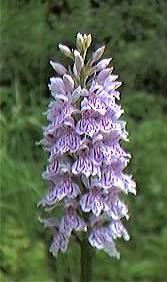 | Orchid, common spotted, Dactylorhiza fuchsii
 The commonest of the Dactylorchis group of orchids, spotted orchids often grown prolifically in areas they like, which include undisturbed grassland and glades or track-sides in old woods. The colour varies from almost white to dark rose pink, with a delicate pattern of darker lines and spots. The paler specimen (right) shows the typical form of the flower-spike in bud, compared to the fully-out specimen in the main picture. 17.6.99 The commonest of the Dactylorchis group of orchids, spotted orchids often grown prolifically in areas they like, which include undisturbed grassland and glades or track-sides in old woods. The colour varies from almost white to dark rose pink, with a delicate pattern of darker lines and spots. The paler specimen (right) shows the typical form of the flower-spike in bud, compared to the fully-out specimen in the main picture. 17.6.99 |
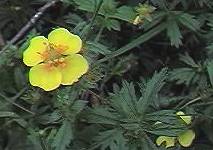 | Tormentil, Potentilla erecta
Very common on the moors and in woodland on non-calcareous soils, this delicate little flower is in fact a cinquefoil or Potentilla. The specific name erecta is misleading as it frequently sprawls across the ground and is rarely more than four or five inches tall. Occasionally the flowers have 5 petals like the other cinquefoils, but the archetypal tormentil is 4-petalled and usually only ¼" or so across. 17.6.99; 21/6/2000 (left). The specific name erecta is misleading as it frequently sprawls across the ground and is rarely more than four or five inches tall. Occasionally the flowers have 5 petals like the other cinquefoils, but the archetypal tormentil is 4-petalled and usually only ¼" or so across. 17.6.99; 21/6/2000 (left). |
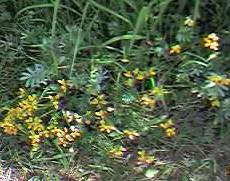 | Birdsfoot trefoil, Lotus corniculatus
Birdsfoot trefoil is very common in grassland and along the sides of rides in woodland.  Sometimes the flowers are tinted red, especially on hot, sunny banks (right). The group in the picture were growing in woodland along with other flowers such as silverweed, clover and herb robert. The name comes from the shape of the seed-pods which resemble a bird’s foot. 17.6.99 Sometimes the flowers are tinted red, especially on hot, sunny banks (right). The group in the picture were growing in woodland along with other flowers such as silverweed, clover and herb robert. The name comes from the shape of the seed-pods which resemble a bird’s foot. 17.6.99 |
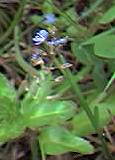 | Brooklime, Veronica beccabunga
 Brooklime is a water-loving speedwell which grows either in water (at the edge of becks or ponds for instance) or in damp, marshy areas and ditches, often in woods. The flowers are an intense blue which show up well against the rather large, shiny leaves (right, 27.7.99). It is common in Ryedale. 17.6.99 Brooklime is a water-loving speedwell which grows either in water (at the edge of becks or ponds for instance) or in damp, marshy areas and ditches, often in woods. The flowers are an intense blue which show up well against the rather large, shiny leaves (right, 27.7.99). It is common in Ryedale. 17.6.99 |
 | Speedwell, thyme-leaved, Veronica serpyllifolia
One of the smaller speedwells, thyme-leaved has the flowers in a terminal spike. They are almost white, with fine blue veining seen in close-up. This speedwell is common on waste ground, in woods, etc., and as a garden weed. |
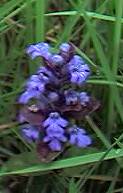 | Bugle, Ajuga reptans
Very common in woods and hedge bottoms, bugle often grows in patches. A dark-leaved, luxuriant form is sometimes grown in gardens. 17.6.99 |
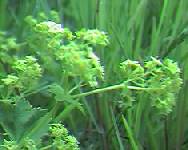 | Lady’s mantle, Alchemilla sp.
Lady’s mantle grows in old grassland and in woods. The wild forms are smaller than those found in gardens, but they are very variable, anything from about an inch to almost a foot tall. There are actually several Alchemilla species in Britain, but they are not easy to tell apart; the pictured specimen from woodland is probably A. xanthochlora, a rather robust form with leaves hairy only underneath. 17.6.99 |
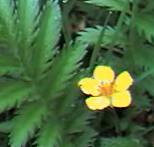 | Silverweed, Potentilla anserina
Silverweed is actually a cinquefoil, but does not have the typical 5-fold leaves; instead it has pinnately-divided ones which are silver-white underneath, hence the name. It is one of the few flowers that can be easily and immediately recognised from the leaves alone. The flowers are a very recognisable yellow, with a rather matt (rather than shiny) surface. Silverweed is common on roadsides, waste ground, woodland rides etc., providing a splash of colour through the summer. 17.6.99 |
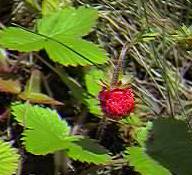 | Strawberry, wild, Fragaria vesca
The wild strawberry is very much smaller than its garden cousin, with white flowers (right. The tiny fruits are delicious, with a rather more fragrant flavour than most cultivated berries. The plant is common in woodland and some grassland, but finding enough fruit for a bowlful to eat is a challenge! 17.6.99 |
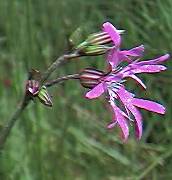 | Ragged robin, Lychnis flos-cuculi
Ragged robin is a plant of wet fields and marshes, usually away from lime. Related to campion, the characteristic raggedy flowers used to be common, but increasingly drainage and “improvement” are reducing the habitat and the plant is becoming quite rare. This specimen was growing in a boggy patch of woodland. 17.6.99 |
 | Speedwell, heath, Veronica officinalis
Heath speedwell is common on heathland and in the drier parts of woods, usually on acid soils. The flowers, which are in spikes arising from the leaf bases, are pale blue or purplish, with fine darker lines (acting as guides for pollinating insects). 10.6.2000 |
 | Biting Stonecrop or Wall Pepper, Sedum acre
This little yellow stonecrop is common on walls and roofs. Sometimes the whole plant is reddish, especially in hot, dry places. This specimen was photographed on a garden wall in Gilling. 21.6.99 |
 | Climbing Corydalis, Ceratocapnos claviculata
Climbing Corydalis is related to the common garden plant Yellow corydalis, and shares its tube-shaped flowers, but they are much smaller and cream rather than butter yellow;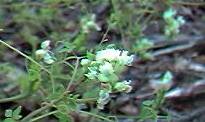 also the wild plant has tendrils and scrambles up the undergrowth in the woods in which it grows. It is an annual which grows amazingly quickly, first showing its flowers in late May. This plant is quite rare nationally, but grows well in Ryedale, being quite common locally in woodland. 21.6.99 also the wild plant has tendrils and scrambles up the undergrowth in the woods in which it grows. It is an annual which grows amazingly quickly, first showing its flowers in late May. This plant is quite rare nationally, but grows well in Ryedale, being quite common locally in woodland. 21.6.99 |
 | Stonecrop, white, Sedum album
White stonecrop is common on walls near houses, and often grows with Wall Pepper (above). In dry places it is often dwarfed, and the whole plant can turn red. The individual flowers are a little smaller than Wall Pepper’s. 29.6.99 |
 | Fumitory, Fumaria sp.
Fumitory is a common weed of disturbed ground. This specimen was growing in recently-dug grassland, along with field pansies and other “weeds”. There are numerous sub-species of fumitories, but they need an expert to identify them reliably! The name derives from the greyish “smoky” appearance of the leaves of at least some of the sub-species. 29.6.99 |
 | Red Campion, Silene dioica
Red Campion is actually pink, the colour varying from a pale rose-pink to almost cerise.  Campions are related to pinks, as can be seen from the detailed form of the flowers (right). Red Campion is common in woods and hedge-banks throughout Ryedale, and flowers over an extended period from April onwards. 29.6.99 Campions are related to pinks, as can be seen from the detailed form of the flowers (right). Red Campion is common in woods and hedge-banks throughout Ryedale, and flowers over an extended period from April onwards. 29.6.99 |
 | Agrimony, Agrimonia eupatoria
Agrimony is quite common in grassland verges, the edges of woodland rides and similar places. The yellow flowers grow in a spike about a foot tall, giving way to fruits like tiny burrs with hooked hairs (not too surprising considering it is related to the avens (Geum spp.) with their hooked fruits). 29.6.99 |
 | Marsh Thistle, Cirsium palustre
Marsh thistles are one of the commonest thistles in Ryedale, growing almost anywhere the ground is marshy, especially in woodland. They are rather untidy plants with relatively small prickles, but plenty of them. The flowers occur in rather congested heads at the top of the plant, which is usually some 3 feet tall, but can grow up to 7 or 8 feet – there are usually spectacular specimens on display in the “Tallest Weed” competition at Bilsdale Show. Marsh thistles are readily recognised by the purple-tipped prickles in the egg-shaped cup of sepal-like bracts; the flowers are usually some shade of purple, but there seem to be a relatively large number of albino, white-flowered specimens in Ryedale (though these usually still show the purple-tipped bracts), which are often rather spindly and weak-looking plants. 29.6.99 |
 | Self Heal, Prunella vulgaris
A very common little plant in old grassland, old lawns un-poisoned by chemicals, verges, woodland etc., self-heal is small and rather inconspicuous, but pretty in close-up. Its name reflects its old uses in folk medicine. 29.6.99 |
 | Crosswort, Galium cruciata
A curious member of the bedstraw family, crosswort has green flowers set in whorls. The leaves are in fours set in a cross-like formation, and the whole plant is rather stiff. It is very common on roadside verges, and its characteristic yellow-green can be easily picked out even from a distance. 29.6.99 |
 | Honeysuckle, Lonicera periclymenum
Honeysuckle is common in all Ryedale woods and many hedges.  It flowers profusely, though each individual flower only lasts a day or so. The flowers are very beautiful in close-up (right), and of course have the most wonderful sweet scent. 29.6.99 It flowers profusely, though each individual flower only lasts a day or so. The flowers are very beautiful in close-up (right), and of course have the most wonderful sweet scent. 29.6.99 |
 | Marsh Lousewort, Pedicularis palustris
A curious plant, Lousewort is a partial parasite, feeding off the roots of other plants, primarily grasses.  It does have leaves, which are so finely divided they resemble fern fronds. Often the whole plant is purplish or bronzy. There are two species, of which Marsh Lousewort is the larger. The pink flowers are two-lipped (see detail, right), with four tiny teeth on the top part - the only reliable distinction from its generally smaller relative Common or Heath Lousewort which has two and prefers more acid conditions. Marsh Lousewort is not uncommon in its preferred location of neutral or limy wetland or rich fenland, but this is sadly a diminishing habitat. This specimen was growing north of Pickering. 6.6.2000. It does have leaves, which are so finely divided they resemble fern fronds. Often the whole plant is purplish or bronzy. There are two species, of which Marsh Lousewort is the larger. The pink flowers are two-lipped (see detail, right), with four tiny teeth on the top part - the only reliable distinction from its generally smaller relative Common or Heath Lousewort which has two and prefers more acid conditions. Marsh Lousewort is not uncommon in its preferred location of neutral or limy wetland or rich fenland, but this is sadly a diminishing habitat. This specimen was growing north of Pickering. 6.6.2000. |
 | Meadow Thistle, Cirsium dissectum
A rather un-thistle-like thistle, only softly spiny rather than prickly, with white hairs on the underside of the leaves. This plant was unfortunately not fully out, but it should open into a typical purple thistle-like flower-head. Meadow Thistle is a southern plant, reaching the limit of its distribution in Yorkshire. 6.6.2000. |
 | Lesser Spearwort, Ranunculus flammula
Spearwort is a species of buttercup, and has the typical yellow flowers of the genus, perhaps a little paler than the ‘dry land’ buttercups. However, the leaves are quite different, being long and narrow, almost like those of grasses. A wetland species, spearwort is common all over Ryedale. This particular specimen was photographed in the same fen as the Marsh Lousewort and Meadow Thistle above. 6.6.2000. |
 | Greater Butterfly Orchid, Platanthera chlorantha
A beautiful orchid up to a foot or so tall, Greater Butterfly Orchids can be found at a handful of sites in Ryedale, usually on the southern limestone either in ancient woods or at their edges/in more open glades. The individual flowers have a greenish tinge (hence the specific name chlorantha which means “green flower”), and have an extremely long spur (see detail, right – the spur is behind the flower’s stalk, and extends to the left of the main stem). They are apparently fragrant at night, and are probably pollinated by night-flying moths, which must have very long tongues to reach the nectar at the farthest end of the spur! 8.6.2000. The individual flowers have a greenish tinge (hence the specific name chlorantha which means “green flower”), and have an extremely long spur (see detail, right – the spur is behind the flower’s stalk, and extends to the left of the main stem). They are apparently fragrant at night, and are probably pollinated by night-flying moths, which must have very long tongues to reach the nectar at the farthest end of the spur! 8.6.2000. |
 | Chickweed Wintergreen, Trientalis europaea
A charming little plant, only about 3" tall, which grows in woodland, usually under bracken and on fairly acid soils.  Its distribution is very patchy, but where it does occur there are often many plants (see for instance right). This plant is fairly common in Scotland, uncommon in northern England and absent in the south. The flowers are usually white, but they can have a delicate suggestion of pink, especially when they are in bud. 12.6.2000 Its distribution is very patchy, but where it does occur there are often many plants (see for instance right). This plant is fairly common in Scotland, uncommon in northern England and absent in the south. The flowers are usually white, but they can have a delicate suggestion of pink, especially when they are in bud. 12.6.2000 |
 | Bush Vetch, Vicia sepium
Probably the commonest vetch, and the first to flower, this peaflower grows in rough grassland, particularly roadside verges and hedge bottoms. The flowers are a curious, rather muddy shade of blue. 12.6.2000 |
 | Wood Avens, Geum urbanum
A rather weedy plant with small yellow flowers, very common in woodland of all types, and occurring as a weed in gardens near woods. The seed-heads are hooked, like small burrs, so that they can be transported on the coats of passing animals. 12.6.2000 |
 | Black Bryony, Tamus communis
A member of the yam family! A rather undistinguished twining plant with shiny heart- or arrow-shaped leaves and small, green 6-petalled flowers, black bryony gorws in woods and hedges. It is rather more obvious in autumn when it produces bright red berries. 12.6.2000 |
 | Woody Nightshade or Bittersweet, Solanum dulcamara
Related to tomatoes and potatoes, bittersweet shows the characteristic flower shape of this family with turned back petals surrounding a central “core” of anthers. It is fairly common in places such as stream-banks and some hedges, scrambling up through other vegetation in a rather untidy fashion. The flowers are small, but very beautiful close up. The fruits are bright red berries which are unfortunately poisonous. 19.6.2000. |
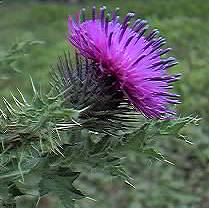 | Welted Thistle, Carduus crispus
A relatively uncommon thistle, with very conspicuous green spines (not actually all that sharp) surrounding the flower. The plant is some 2–3 feet tall, rather like a lush marsh thistle, but the flowers are a little larger and a brighter purple. It tends to grow in disturbed ground, such as recently dug verges, set-aside fields and the like, and is casual in the sense that it may not re-appear in the same place in consecutive years. 19/6/2000. |
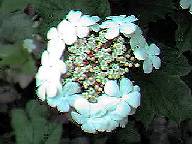 | Guelder Rose, Viburnum opulus
A common shrub in Ryedale hedges and woodland edges, especially on the southern limestone hills. The showy white flowers do not last long, but are a wonderful sight when they are in full bloom. Later in the year they develop into translucent red berries which are almost as striking. 19/6/2000. |
 | Yellow Flag or Iris, Iris pseudocorus
 The only wild iris you are likely to see in Ryedale, the yellow flag is common at the edge of ponds and in marsh and marshy ditches where the water is not too acid, but like many wetland plants its habitat has been much reduced. The plants are rather leafy, and the flowers not particularly showy, but close up they are beautifully veined, and show the classic iris form as seen in many garden varieties, with all the parts in threes. 19/6/2000. 4/6/2003 The only wild iris you are likely to see in Ryedale, the yellow flag is common at the edge of ponds and in marsh and marshy ditches where the water is not too acid, but like many wetland plants its habitat has been much reduced. The plants are rather leafy, and the flowers not particularly showy, but close up they are beautifully veined, and show the classic iris form as seen in many garden varieties, with all the parts in threes. 19/6/2000. 4/6/2003 |
 | Downy Rose, Rosa villosa
A fairly common wild rose, distinguished from the common dog rose by its very particular deep pink flowers, and also the smaller, greyer, softly downy leaves that give the plant its name. Downy roses seem to have a liking for lime, and are most often seen on the southern Tabular Hills on the Corallian limestones 19/6/2000. |
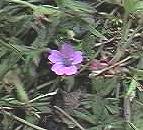 | Cut-leaved Cranesbill, Geranium dissectum
One of the small-flowered Geranium species, cut-leaved cranesbill has flowers like a tiny herb robert with notched petals, and finely divided leaves. It is a rather untidy, sprawling plant, which can vary from just a few inches tall to a foot or so, depending on its habitat (e.g. whether it is grazed off by sheep). It is very common, especially in grassy waste-land, hedge-bottoms, set-aside fields, as a garden weed etc. 19/6/2000. |
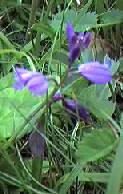 | Common Milkwort, Polygala vulgaris
A tiny plant of grassland, with blue or purple flowers which have a peculiar flattened form, shared with the closely related heath milkwort. It is not uncommon, but probably overlooked under the grass. It has all its leaves alternate (unlike the Heath milkwort which has at least the lower leaves alternate) and is generally a little larger and laxer, with usually paler flowers. It grows in grassland rather than on heath or moorland. 19/6/2000. |
 | Lesser Butterfly Orchid, Platanthera bifolia
A very beautiful orchid, similar to the Greater Butterfly Orchid, but lacking the greenish tinge.  The flowers can be told apart by the “pollen masses”, which are parallel in this species, but diverge from the top in the greater. The flowers have a tremendously long, fine spur with nectar at the end, and are probably pollinated by long-tongued moths. These lesser butterfly orchids were growing in reasonable numbers on a patch of moorland close to the limestone scarp, together with fragrant orchids, so there is probably lime in the soil despite the heather and other moorland vegetation. 23/6/2000. The flowers can be told apart by the “pollen masses”, which are parallel in this species, but diverge from the top in the greater. The flowers have a tremendously long, fine spur with nectar at the end, and are probably pollinated by long-tongued moths. These lesser butterfly orchids were growing in reasonable numbers on a patch of moorland close to the limestone scarp, together with fragrant orchids, so there is probably lime in the soil despite the heather and other moorland vegetation. 23/6/2000. |
 | Heath Orchid, Dactylorhiza maculata
The moorland counterpart of common spotted orchid, with which it hybridises. Heath Spooted orchids are variable, but tend to be smaller than Commons, with beautiful pink-purple markings on the petals; the lower petal or lip is evenly toothed, rather than having the three obvious lobes of D. fuchsii A plant with a patchy distribution, it can be quite common, often growing among cross-leaved heath. This specimen was growing close to the lesser butterfly and fragrant orchids shown here. 23/6/2000. |
 |  Fragrant Orchid, Gymnadenia conopsea Fragrant Orchid, Gymnadenia conopsea
One of the most beautiful orchids, with delicate rose-pink flowers bearing a long, curved spur and producing a strong vanilla- or clove-like scent (which distinguishes them from the superficially similar Pyramidal Orchid). Although they normally grow in grassland this specimen was one of a scattered group growing amongst predominantly moorland vegetation together with lesser butterfly orchids. The plant shown right was in a more expected habitat of limestone grassland near Ellerburn. 23/6/2000; 5/7/2000. |

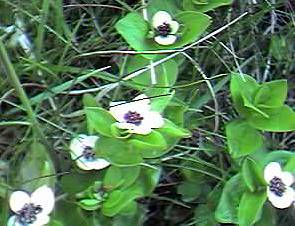
| Dwarf Cornel, Cornus suecica
A real rarity, this small relative of Dogwood is an arctic relic which normally grows in Scandinavia and northern Scotland. There are a few patches of it on north-facing slopes in the vicinity of the Hole of Horcum, but it is difficult to find as it is only about 6" tall, grows under bracken, and has rather inconspicuous flowers followed by red berries. Unfortunately this specimen had finished flowering and only the berries were to be seen. The leaves have the characteristic veining pattern of the family, also seen in the shrub Common Dogwood.
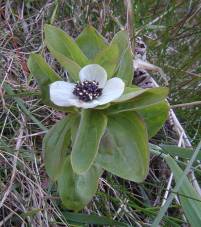
On a later trip we did manage to find some flowers (left below and detail, right). What appear to be white petals are in fact leaf-like bracts, that start green, become white, and rapidly fade to brown before falling. The true flowers are the small dark structures within these bracts.
26/6/2000 (berry); 19/5/2003 (flowers) |
 | Heath Milkwort, Polygala serpyllifolia
 The moorland counterpart of Common Milkwort, this tiny plant usually has intense blue flowers although they can be purplish (see right), pale blue or even pure white. They have the same curious flattened form as Common Milkwort. Heath Milkwort is usually smaller and neater than its cousin, often no more than an inch high; the leaves are small and neat, usually opposite, resembling those of thyme, hence the specific name. It is quite common on the moors, among short heather or acid grassland. 26/6/2000. The moorland counterpart of Common Milkwort, this tiny plant usually has intense blue flowers although they can be purplish (see right), pale blue or even pure white. They have the same curious flattened form as Common Milkwort. Heath Milkwort is usually smaller and neater than its cousin, often no more than an inch high; the leaves are small and neat, usually opposite, resembling those of thyme, hence the specific name. It is quite common on the moors, among short heather or acid grassland. 26/6/2000. |
 | Bladder Campion, Silene vulgaris
Despite its Latin name, not a particularly common plant, Bladder Campion grows on dry, rather thin grassland, usually on limestone; it is common around Cauklass Bank, appearing on roadside verges. A very easy campion to identify with the inflated “bladder” of the calyx, which enlarges in fruit, rather small white flowers and bluish-grey leaves. 26/6/2000. |
 | Marsh Cinquefoil, Potentilla palustris
 A rather atypical cinquefoil, with dark maroon flowers whose prominent sepals appear to be extra petals, although the leaves are recognisably similar to other members of the Potentilla family. A not uncommon plant in bogs. A particularly splendid group of plants grows alongside the railway in mid-Newtondale. 26/6/2000. A rather atypical cinquefoil, with dark maroon flowers whose prominent sepals appear to be extra petals, although the leaves are recognisably similar to other members of the Potentilla family. A not uncommon plant in bogs. A particularly splendid group of plants grows alongside the railway in mid-Newtondale. 26/6/2000. |
 | Cranberry, Vaccinium oxycoccus
An uncommon plant growing in a few moorland bogs (and very difficult to find – we stumbled upon this plant while looking for othet things!).  Unfortunately this is not a good photo, but it does show the tiny pink flower with turned-back petals on a thread-like stalk. The whole plant is tiny and very dainty, less than an inch tall. The fruits are small reddish berries, edible but not the larger juicy berries we see at Christmas (which are imported from America). 26/6/2000. Unfortunately this is not a good photo, but it does show the tiny pink flower with turned-back petals on a thread-like stalk. The whole plant is tiny and very dainty, less than an inch tall. The fruits are small reddish berries, edible but not the larger juicy berries we see at Christmas (which are imported from America). 26/6/2000. |
 | Sundew, Drosera rotundifolia
A curious little plant, sundew is insectivorous, supplementing its diet from its mineral-poor habitat by catching and digesting small flies. It has sticky glands on its leaves, which curl in and trap any insect landing on them.  Sundew is only a couple of inches tall, even in flower (this photo unfortunately does not show the pretty white flowers as I was too early), and not uncommon in boggy, acid areas on the moors, especially among Sphagnum moss. It seems to have suffered in the recent dry years, but be making a welcome comeback after a couple of wetter springs. 26/6/2000. Detail 30/8/2000 Sundew is only a couple of inches tall, even in flower (this photo unfortunately does not show the pretty white flowers as I was too early), and not uncommon in boggy, acid areas on the moors, especially among Sphagnum moss. It seems to have suffered in the recent dry years, but be making a welcome comeback after a couple of wetter springs. 26/6/2000. Detail 30/8/2000 |
 | Cross Leaved Heath, Erica tetralix
The third heather of the moors with Ling and Bell Heather, cross leaved heath tends to grow in the damper areas, and flower first. Sometimes the flowers are white, but the common colour is a rosy pink, and the plants grow in a charactersitic tufted fashion. Common on the moors, but also grows in the damper parts of heathy woods. 26/6/2000. |
 | Heath Lousewort, Pedicularis sylvatica
 Semi-parasitic on the grasses with which it grows, like its cousin Marsh Lousewort. This plant is generally smaller and grows on acid heathland, often in damper areas, for instance on becksides. It has small leaves, often purply-bronze. The pink flowers are very similar to those of Marsh Lousewort except that they have only two tiny teeth on the upper lip. 3/6/2001. Semi-parasitic on the grasses with which it grows, like its cousin Marsh Lousewort. This plant is generally smaller and grows on acid heathland, often in damper areas, for instance on becksides. It has small leaves, often purply-bronze. The pink flowers are very similar to those of Marsh Lousewort except that they have only two tiny teeth on the upper lip. 3/6/2001. |
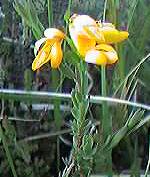 | Petty Whin, Genista anglica
Like a tiny, delicate gorse, usually under a foot tall, this pretty peaflower has clear yellow flowers a little paler than its cousin. It grows amongst the heather, and is perhaps overlooked and commoner than it appears! 3/6/2001. |


 It used to be much commoner, but as the plant acts as an intermediate host for a fungal rust disease of barley most of it was eradicated. There are still one or two plants to be found in Ryedale, growing in old-established hedges. The picture shows the characteristic 3-way spines on a new shoot, and the inset is of the flowers. 15.6.99
It used to be much commoner, but as the plant acts as an intermediate host for a fungal rust disease of barley most of it was eradicated. There are still one or two plants to be found in Ryedale, growing in old-established hedges. The picture shows the characteristic 3-way spines on a new shoot, and the inset is of the flowers. 15.6.99



 Field pansies are much smaller than their garden relatives, with the cream petals usually shorter than the sepals and the whole flower no more than ¾" across. They were common in arable land until recently, but are now hard to find. This specimen (left) was growing at the edge of a crop-field and was unfortunately sprayed the day after the picture was taken. 15.6.99. I managed to find another, rather lusher specimen away from the spray-zone a few days later (right).
Field pansies are much smaller than their garden relatives, with the cream petals usually shorter than the sepals and the whole flower no more than ¾" across. They were common in arable land until recently, but are now hard to find. This specimen (left) was growing at the edge of a crop-field and was unfortunately sprayed the day after the picture was taken. 15.6.99. I managed to find another, rather lusher specimen away from the spray-zone a few days later (right).
 The common corn poppy produces hundreds of seeds, which lie dormant until the ground is turned over, when whole areas can become covered in them. A field of poppies is unfortunately now not a common sight, though sometimes a field misses out on the weedkiller (right). Unfortunately this patch was sprayed shortly after the picture was taken, killing the poppies, field pansies and other “weeds” that were growing there. Close up the poppy flower is really quite exotic (left). 15.6.99
The common corn poppy produces hundreds of seeds, which lie dormant until the ground is turned over, when whole areas can become covered in them. A field of poppies is unfortunately now not a common sight, though sometimes a field misses out on the weedkiller (right). Unfortunately this patch was sprayed shortly after the picture was taken, killing the poppies, field pansies and other “weeds” that were growing there. Close up the poppy flower is really quite exotic (left). 15.6.99




 The commonest of the Dactylorchis group of orchids, spotted orchids often grown prolifically in areas they like, which include undisturbed grassland and glades or track-sides in old woods. The colour varies from almost white to dark rose pink, with a delicate pattern of darker lines and spots. The paler specimen (right) shows the typical form of the flower-spike in bud, compared to the fully-out specimen in the main picture. 17.6.99
The commonest of the Dactylorchis group of orchids, spotted orchids often grown prolifically in areas they like, which include undisturbed grassland and glades or track-sides in old woods. The colour varies from almost white to dark rose pink, with a delicate pattern of darker lines and spots. The paler specimen (right) shows the typical form of the flower-spike in bud, compared to the fully-out specimen in the main picture. 17.6.99
 The specific name erecta is misleading as it frequently sprawls across the ground and is rarely more than four or five inches tall. Occasionally the flowers have 5 petals like the other cinquefoils, but the archetypal tormentil is 4-petalled and usually only ¼" or so across. 17.6.99; 21/6/2000 (left).
The specific name erecta is misleading as it frequently sprawls across the ground and is rarely more than four or five inches tall. Occasionally the flowers have 5 petals like the other cinquefoils, but the archetypal tormentil is 4-petalled and usually only ¼" or so across. 17.6.99; 21/6/2000 (left).
 Sometimes the flowers are tinted red, especially on hot, sunny banks (right). The group in the picture were growing in woodland along with other flowers such as silverweed, clover and herb robert. The name comes from the shape of the seed-pods which resemble a bird’s foot. 17.6.99
Sometimes the flowers are tinted red, especially on hot, sunny banks (right). The group in the picture were growing in woodland along with other flowers such as silverweed, clover and herb robert. The name comes from the shape of the seed-pods which resemble a bird’s foot. 17.6.99
 Brooklime is a water-loving speedwell which grows either in water (at the edge of becks or ponds for instance) or in damp, marshy areas and ditches, often in woods. The flowers are an intense blue which show up well against the rather large, shiny leaves (right, 27.7.99). It is common in Ryedale. 17.6.99
Brooklime is a water-loving speedwell which grows either in water (at the edge of becks or ponds for instance) or in damp, marshy areas and ditches, often in woods. The flowers are an intense blue which show up well against the rather large, shiny leaves (right, 27.7.99). It is common in Ryedale. 17.6.99









 also the wild plant has tendrils and scrambles up the undergrowth in the woods in which it grows. It is an annual which grows amazingly quickly, first showing its flowers in late May. This plant is quite rare nationally, but grows well in Ryedale, being quite common locally in woodland. 21.6.99
also the wild plant has tendrils and scrambles up the undergrowth in the woods in which it grows. It is an annual which grows amazingly quickly, first showing its flowers in late May. This plant is quite rare nationally, but grows well in Ryedale, being quite common locally in woodland. 21.6.99


 Campions are related to pinks, as can be seen from the detailed form of the flowers (right). Red Campion is common in woods and hedge-banks throughout Ryedale, and flowers over an extended period from April onwards. 29.6.99
Campions are related to pinks, as can be seen from the detailed form of the flowers (right). Red Campion is common in woods and hedge-banks throughout Ryedale, and flowers over an extended period from April onwards. 29.6.99




 It flowers profusely, though each individual flower only lasts a day or so. The flowers are very beautiful in close-up (right), and of course have the most wonderful sweet scent. 29.6.99
It flowers profusely, though each individual flower only lasts a day or so. The flowers are very beautiful in close-up (right), and of course have the most wonderful sweet scent. 29.6.99
 It does have leaves, which are so finely divided they resemble fern fronds. Often the whole plant is purplish or bronzy. There are two species, of which Marsh Lousewort is the larger. The pink flowers are two-lipped (see detail, right), with four tiny teeth on the top part - the only reliable distinction from its generally smaller relative Common or
It does have leaves, which are so finely divided they resemble fern fronds. Often the whole plant is purplish or bronzy. There are two species, of which Marsh Lousewort is the larger. The pink flowers are two-lipped (see detail, right), with four tiny teeth on the top part - the only reliable distinction from its generally smaller relative Common or 


 The individual flowers have a greenish tinge (hence the specific name chlorantha which means “green flower”), and have an extremely long spur (see detail, right – the spur is behind the flower’s stalk, and extends to the left of the main stem). They are apparently fragrant at night, and are probably pollinated by night-flying moths, which must have very long tongues to reach the nectar at the farthest end of the spur! 8.6.2000.
The individual flowers have a greenish tinge (hence the specific name chlorantha which means “green flower”), and have an extremely long spur (see detail, right – the spur is behind the flower’s stalk, and extends to the left of the main stem). They are apparently fragrant at night, and are probably pollinated by night-flying moths, which must have very long tongues to reach the nectar at the farthest end of the spur! 8.6.2000.
 Its distribution is very patchy, but where it does occur there are often many plants (see for instance right). This plant is fairly common in Scotland, uncommon in northern England and absent in the south. The flowers are usually white, but they can have a delicate suggestion of pink, especially when they are in bud. 12.6.2000
Its distribution is very patchy, but where it does occur there are often many plants (see for instance right). This plant is fairly common in Scotland, uncommon in northern England and absent in the south. The flowers are usually white, but they can have a delicate suggestion of pink, especially when they are in bud. 12.6.2000






 The only wild iris you are likely to see in Ryedale, the yellow flag is common at the edge of ponds and in marsh and marshy ditches where the water is not too acid, but like many wetland plants its habitat has been much reduced. The plants are rather leafy, and the flowers not particularly showy, but close up they are beautifully veined, and show the classic iris form as seen in many garden varieties, with all the parts in threes. 19/6/2000. 4/6/2003
The only wild iris you are likely to see in Ryedale, the yellow flag is common at the edge of ponds and in marsh and marshy ditches where the water is not too acid, but like many wetland plants its habitat has been much reduced. The plants are rather leafy, and the flowers not particularly showy, but close up they are beautifully veined, and show the classic iris form as seen in many garden varieties, with all the parts in threes. 19/6/2000. 4/6/2003



 The flowers can be told apart by the “pollen masses”, which are parallel in this species, but diverge from the top in the greater. The flowers have a tremendously long, fine spur with nectar at the end, and are probably pollinated by long-tongued moths. These lesser butterfly orchids were growing in reasonable numbers on a patch of moorland close to the limestone scarp, together with fragrant orchids, so there is probably lime in the soil despite the heather and other moorland vegetation. 23/6/2000.
The flowers can be told apart by the “pollen masses”, which are parallel in this species, but diverge from the top in the greater. The flowers have a tremendously long, fine spur with nectar at the end, and are probably pollinated by long-tongued moths. These lesser butterfly orchids were growing in reasonable numbers on a patch of moorland close to the limestone scarp, together with fragrant orchids, so there is probably lime in the soil despite the heather and other moorland vegetation. 23/6/2000.

 Fragrant Orchid, Gymnadenia conopsea
Fragrant Orchid, Gymnadenia conopsea



 The moorland counterpart of
The moorland counterpart of 

 A rather atypical cinquefoil, with dark maroon flowers whose prominent sepals appear to be extra petals, although the leaves are recognisably similar to other members of the Potentilla family. A not uncommon plant in bogs. A particularly splendid group of plants grows alongside the railway in mid-Newtondale. 26/6/2000.
A rather atypical cinquefoil, with dark maroon flowers whose prominent sepals appear to be extra petals, although the leaves are recognisably similar to other members of the Potentilla family. A not uncommon plant in bogs. A particularly splendid group of plants grows alongside the railway in mid-Newtondale. 26/6/2000.
 Unfortunately this is not a good photo, but it does show the tiny pink flower with turned-back petals on a thread-like stalk. The whole plant is tiny and very dainty, less than an inch tall. The fruits are small reddish berries, edible but not the larger juicy berries we see at Christmas (which are imported from America). 26/6/2000.
Unfortunately this is not a good photo, but it does show the tiny pink flower with turned-back petals on a thread-like stalk. The whole plant is tiny and very dainty, less than an inch tall. The fruits are small reddish berries, edible but not the larger juicy berries we see at Christmas (which are imported from America). 26/6/2000.
 Sundew is only a couple of inches tall, even in flower (this photo unfortunately does not show the pretty white flowers as I was too early), and not uncommon in boggy, acid areas on the moors, especially among Sphagnum moss. It seems to have suffered in the recent dry years, but be making a welcome comeback after a couple of wetter springs. 26/6/2000. Detail 30/8/2000
Sundew is only a couple of inches tall, even in flower (this photo unfortunately does not show the pretty white flowers as I was too early), and not uncommon in boggy, acid areas on the moors, especially among Sphagnum moss. It seems to have suffered in the recent dry years, but be making a welcome comeback after a couple of wetter springs. 26/6/2000. Detail 30/8/2000

 Semi-parasitic on the grasses with which it grows, like its cousin
Semi-parasitic on the grasses with which it grows, like its cousin 